Flies for river fishing: A mobile friendly guide that helps in matching the hatch
Flies for river fishing content:
This guide on flies for river fishing has been designed to help beginners and the more seasoned anglers identify a fly hatch and recommend a suitable artificial fly pattern.
The flies are organised in the time of the year they would normally start to hatch on UK rivers.
Each natural fly has a brief description covering how to identify it, its habitat, and when you are like to see the fly hatching.
Large Dark Olive:

The Large Dark Olive begins to emerge from late February with the main hatch occurring in spring (March & April). This is followed by a secondary hatch in autumn (September and October). However, small, sporadic hatches will occur throughout the year.
Identification is quite easy because, with the exception of the March Brown, the LDO is often the only fly on the river at the start of spring. Also, the two species differ in both size and wing coloration.
The large dark olive has two tails, a dark olive-brown body (ca. 10mm long) with yellow-olive bands, which is roughly 3/4 the size of the March Brown. However, wing coloration is a more noticeable difference between the two species. The LDO has pale grey wings with brown veins, while March Brown has mottled brown wings.
The large dark olive is found throughout the UK but only in running water.
It survives in all types of running water from fast-flowing mountain streams to slow rivers, including weedy, chalk, and limestone rivers.
Dry fly patterns:

Jingler
- Hook: Kamasan B170 #14 & 12
- Thread: Olive 8/0 Uni
- Tails: Badger cock fibres
- Body: Hends body quill BQ-32
- Hackles: grey partridge & ginger cock
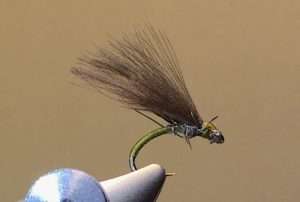
CDC Olive Emerger
- Hook: Kamasan B100 #12 to 18
- Thread: Olive UNI-Thread 8/0
- Thorax: Hare’s ear dubbing
- Wing: 3-4 CDC feathers
Wet fly patterns:
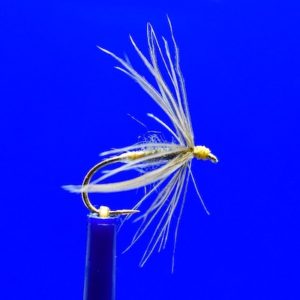
Pearly Butt Waterhen Blog
- Hook: Kamasan B402 #14 &16
- Thread: Primrose silk
- Tag: Pear Mylar (1/32)
- Body: Finely dubbed Mole fur
- Hackle: Waterhen undercover wing
Nymph pattern:
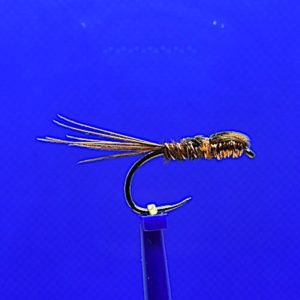
Frank Sawyer’s pheasant tail nymph
- Hook – HENDS BL354 #12 to16
- Thread – Fine copper wire
- Tail – 4 to 5 pheasant tail fibres
- Body – 3 pheasant tail fibres
- Thorax – Fine copper wire
- Wing case – 5 pheasant tail fibres
For additional information on the large dark olive fly check out the following post:
March Brown
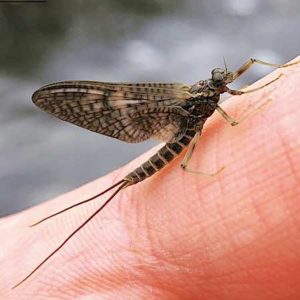
March Browns start to emerge in March with the hatch peaking in early April. The hatches peter out during May and are not seen again until next year.
March Brown duns have distinctive mottled browny wings and the forewings are almost twice the size of the hindwings. It has dark brown bodies ringed with yellow that is about 12-15mm long and has two tails.
Not to be confused with the large dark olive dun which has pale grey wings with brown veins and is larger than the March Brown.
Found in many large spate rivers but by no means all. It is often restricted to certain stretches. Absent from chalk streams ad slow flowing rain-fed rivers.
F
M
A
M
Dry fly patterns:
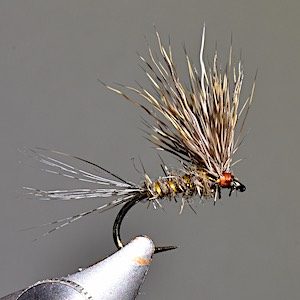
March Brown Upright
- Hook: Kamasan B170 #14 & 12
- Thread: rusty orange 8/0 Uni
- Tails: Grey Partridge fibres
- Body: WAPSI Fox Squirrel
- Rib: Gold floss
- Wing: Deer hair
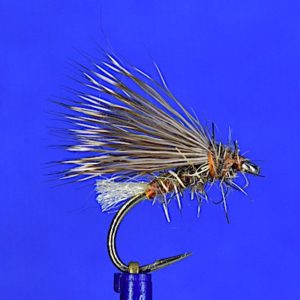
Elk Hair Caddis
- Hook: Kamasan B170 #14 & 12
- Thread: Burnt orange 8/0
- Tails: Cream Antron yarn
- Body: Fox squirrel dubbing
- Rib: Gold wire
- Wing: Natural Elk Hair
Wet fly patterns:

March Brown Wet fly
- Hook: Kamasan B170 #14 & 16
- Thread: Rusty orange 8/0 Uni
- Tail: Grey partridge fibres
- Body: WAPSI Fox squirrel
- Ribe: Gold wire
- Hackle: Brown partridge neck feather
- Wing: Ostrich secondary wings slips
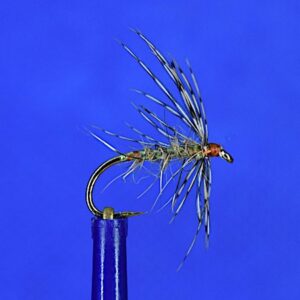
March Brown Spider
- Hook: Partridge L3A-S #14
- Thread: Rusty orange UNI 8/0
- Body: WAPSI Fox Squirrel
- Rib: Glod wire
- Hackle: Brown partridge neck
Nymph pattern:
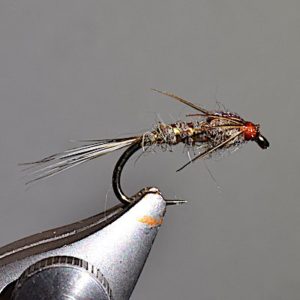
Gold ribbed Hare's Ear
- Hook: Kamasan B170 #14 & 12
- Weight: 4 turns of lead wire
- Thread: Rusty orange 8/0 Uni
- Tail: Badger cock fibres
- Body: WAPSI Hare’s ear
- Rib: Gold tinsel
- Thorax: Hare’s Ear dubbing
- Wing case & legs: 6 pheasant tail fibres
For additional information on the March Brown fly patterns and how to fish them check out the following post:
Grannom Sedge
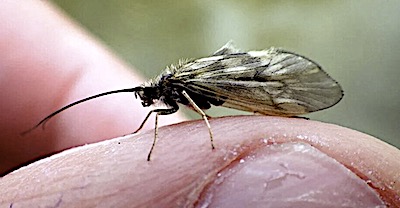
Image courtesy of Gareth Lewis
The Grannom is the first sedge to hatch on the Welsh Dee during April. Once the hatch starts it last for roughly a couple of weeks. When Grannom are on the water trout usually ignore all other flies.
They generally hatch in shallow water during the warmest part of the day, from late morning to mid-afternoon.
Grannom are easy to identify because they are the only sedge fly on the river during April. As the fly emerges it has a green body with black bands, which turns brown in flight. Size 10-12mm.
Grannom are found in most parts of the UK. Hatches are especially intense in England and Wales, and parts of Scotland. They are only found in running water that is not flowing too fast.
M
A
M
Dry fly patterns:
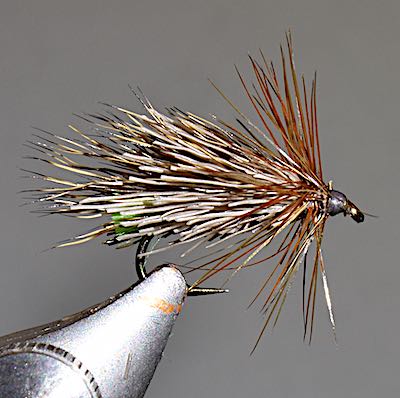
Grannom Sedge dry fly
- Hook: Kamasan B402 #14 & 16
- Thread: Grey 8/0 Uni
- Tail: Green floss
- Body: Deer hair clipped back
- Hackle: Brown cock
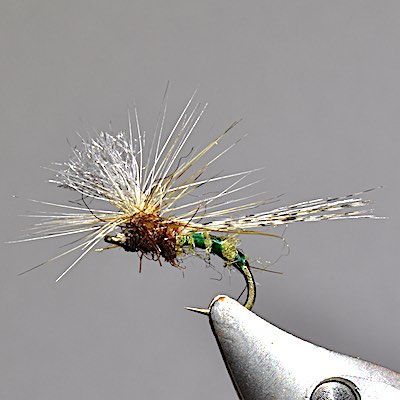
Grannom Emerger fly
- Hook: #14 Drennan Sedge hook
- Thread: Dark Brown 8/0 Uni-Thread
- Para Post: Grey Antron yarn
- Body: 50/50 mix of grey & green Partridge SLF dubbing
- Rib: Clear Mylar coloured on the inside with a green Sharpie
- Rear Wing: Coq de Leon fibres
- Thorax: Brown dubbing
- Hackle: Cree cock feather
Olive Upright
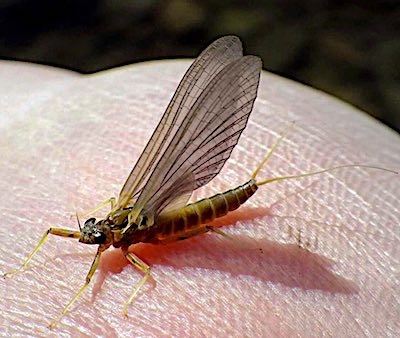
Dun start hatching towards the end of April and continue trickle off the river into August (May and June are the peak months).
Hatches are often heaviest in the evening, which coincides with the appearance of the egg laying spinners.
The Olive Upright is an important spring river fly, and is definitely one to imitate if you are fishing for wild brown trout.
The female dun is slightly larger that male but they are similar in colour: olive-brown bodies with orangish bands, wings are buff in colour.
The Olive Upright is found in most UK rivers and it is probably the most abundant spring fly. The nymphs are flattened stone clingers and found in all kinds of running water, from alkaline chalk streams to acidic spate rivers.
Olive Upright nymphs are about 10mm long and a size 16 pheasant tail nymph is a good imitation.
A
M
J
J
A
Dry fly patterns:

Olive Upright – Parachute
- Hook: Kamasan BL402 (#16 & 14)
- Thread: 8/0 Light Cahill
- Tail: Coq de Leon
- Body: Yellow-olive SLF dubbing
- Post: Cream Antron yarn
- Thorax: Dark olive SLF dubbing
- Hackle: Cree Cock feather
Wet fly patterns:

Pearly Butt Waterhen Blog
- Hook: Kamasan B402 #14 &16
- Thread: Primrose silk
- Tag: Pear Mylar (1/32)
- Body: Finely dubbed Mole fur
- Hackle: Waterhen undercover wing
For additional information on the Olive Upright fly check out the following post:
Hawthorn Fly
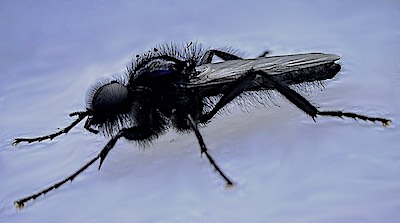
The Hawthorn fly (Bibio Marcia) is also known as The St. Mark’s Fly because large hatches often occur around St. Marks Day (25th of April).
The Hawthorn fly is a small, black and shiny terrestrial fly that are relatively easy to identify. The smaller male is about 12 mm in length, whereas the larger female is roughly 14 mm long.
At rest, the flies translucent wings are folded back over their elongated bond.
The Hawthorn fly is often seen in meadows and on river banks from late April to the end of May. On warm sunny days, large swarms of these terrestrial flies can be seen hovering with the rear legs dangling down.
A
M
J
Fly patterns:
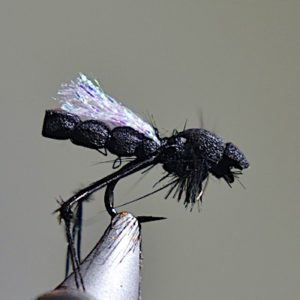
Detached bodied Hawthorn fly
- Hook – Kamasan B110 (#16)
- Thread – Black 8/0
- Body – Ethafoam
- Legs – knotted black pheasant tail fibres
- Wings – Pearl braid
- Thorax – black seals fur
- Hackle – black cock
For additional information on the Hawthorn fly check out the following post:
Alder Fly

From spring to early summer Alderfly larvae crawl from ponds, rivers and lakes. On land, they pupate in damp earth, under rocks and plant litter. Pupation takes a couple of weeks to form the next generation of adult Alderflies.
The adult fly is a large, dark brown insect with veined wings folded over its body. They are often spotted resting on bankside vegetation.
- Length 10-20 mm
- Wingspan 22-34 mm
- Brownish hairless wings with darker veins
- 2 long antennae
The Mud Alderfly (Sialis lutaria) is the most common of the three species found in slow-flowing rivers and stillwaters throughout the UK. It’s one of the most widespread flies because of its ability to survive in acidic to alkaline water environments.
A
M
J
Fly patterns:
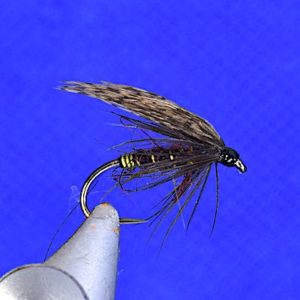
Alder Wet fly
- Hook – #14 Kamasan BL402
- Thread – Black 8/0
- Tag & rib – Olive wire
- Body – 50/50 mix of black & claret seals fur
- Hackle – black hen
- Wing – hen pheasant tail
Iron Blue
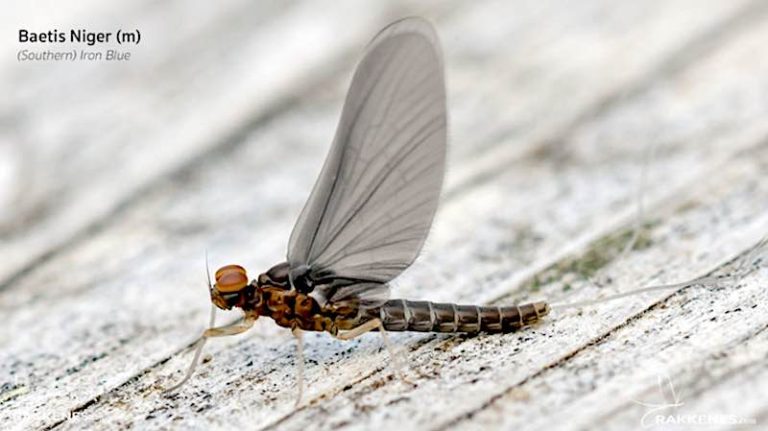
The Iron Blue is widespread on many UK rivers and usually seen hatching from April to October. Peak hatches usually occur from May to the end of June. There is a secondary flurry during September and October.
The Iron blue dun is a small fly (ca. 6mm) compared to the other up-winged flies that are hatching during April and May.
Both sexes of Iron Blue Dun are similar in appearance, having a dark grey-olive body, dark grey-blue wings, and two tails. A notable exception is the colour of their eyes:
- Females have yellow eyes.
- Males have larger brown eyes
The Iron Blue fly emerges from a slender agile-darting nymph that spends the majority of its life in the riffle sections of rivers and streams. Often found in weedy areas and between pebbles and gravel.
A
M
J
J
A
S
O
N
Dry fly patterns:
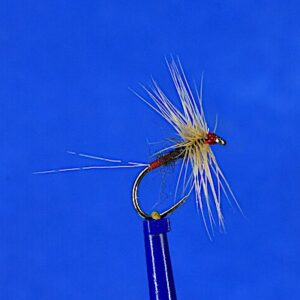
Iron Blue Dun
- Hends BL354 (#14 to #18)
- Claret UNI-thread 8/0
- Tail – Coq De Leon fibres
- Body – mole fur
- Hackle – Iron blue Cock
Wet / Spider fly patterns:
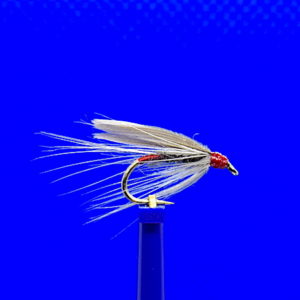
Iron Blue winged wet fly
- Kamasan B402 (#14 & #16)
- Claret UNI-thread 8/0
- Tail – Iron Blue Cock fibres
- Tag – Claret thread
- Body – Moles fur
- Hackle – Iron Blue hen
- Wing – Starling primary wing features
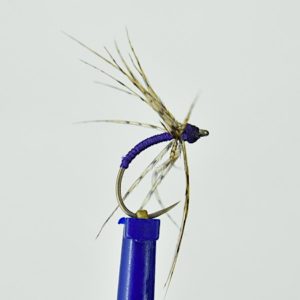
Snipe & Purple
- VARIVAS 2200BL (#16 & #18)
- Thread – Purple Silk
- Hackle – Grey partridge neck
Nymph pattern:
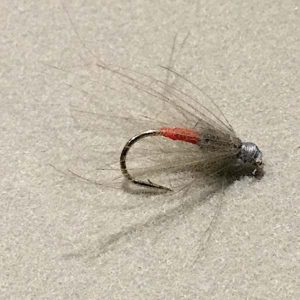
Iron Blue Nymph
- Kamasan B175 (#14 & #16)
- Grey UNI-thread 8/0
- Body rear – red floss
- Thorax – Mole fur
- Legs/hackle CDC feathers
Spinner fly pattern:
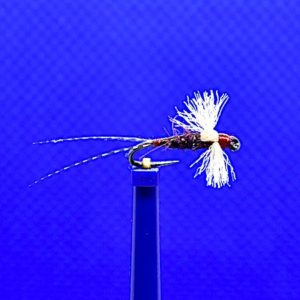
Claret Spinner
- Hends BL354 #16
- Claret 8/0 UBI thread
- Tail – mallard
- Body – claret seals fur sub.
- Rib – brown floss
- Wing – cream Antron
- Wing case – 2mm beige foam
For more information on the Iron Blue fly check out the following post:
Yellow May Dun

The Yellow May Dun is widespread on many UK rivers and usually seen hatching from May to the beginning of August. Peak hatches usually occur in June on most rivers.
As its name suggested the Yellow May Dun is a bright yellow up-winged fly (ca. 10mm) and difficult to mistake.
The female is very similar to the male, but with smaller eyes.
Yellow May nymph is a stone clinger that is found on many spate rivers in the UK. They are easy to find by turning over stones in the riffle section of the river.
The nymphs have flattened bodies with a pale yellow pigmentation and eyes on top of its head. It’s distinguished from other stone clinging nymphs by its broad legs with striped markings and the alternating light and dark markings on its three tails.
M
J
J
A
Dry fly patterns:
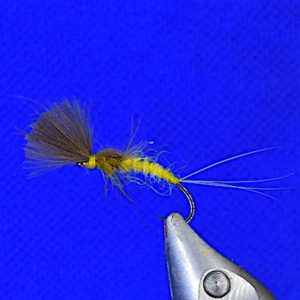
Yellow May CDC Emerger
- Hook: #14 Partridge 15BN Klinkhamer
- Thread: Yellow 8/0 Uni-Thread
- Tail: Yellow cock fibres
- Body: Yellow SLF dubbing
- Rib: 6/0 Yellow Uni-Thread
- Thorax: light olive seals fur sub.
- Wing: 3 CDC feathers (natural or dyed yellow)

Parachute YMD – luminescent post
- Hook: Kamasan B402 (# 14 & 16)
- Thread: Yellow 8/0 Uni-Thread
- Wing Post: White GloYarm
- Tail: Yellow cock fibres
- Body: Yellow SLF dubbing
- Rib: 6/0 Yellow Uni-Thread
- Hackle: Medium Dun genetic cock
Wet fly patterns:
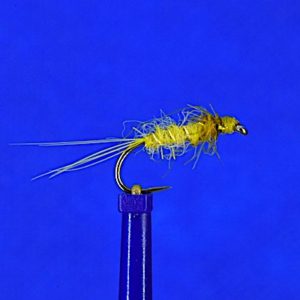
YMD wet fly
- Hook: Kamasan B402 (# 14 & 16)
- Thread: Yellow 8/0 Uni-Thread
- Tail: Yellow cock fibres
- Body: Yellow SLF dubbing
- Thorax: Light Olive seals fur
- Rib: fine gold wire
For more information on the Yellow May Dun check out the following post:
Blue Winged Olive
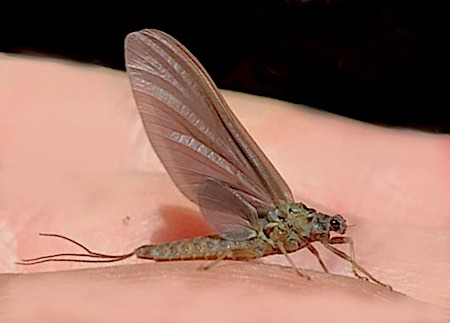
Blue winged olive duns normally hatch when the day warmers up, from the mid-morning to late afternoon.
On the Welsh Dee, peak hatches occur between June and July.
Compared to other up-wing flies, the Blue Winged Olive (Serratella Ignita) is a small (5-7mm) fly. It is identified by its blue-grey wings, three stripy tails, large hind legs, and bodies coloured from green-olive to brown-olive.
Blue winged olive hatches from its nymph which is often found crawling and clinging on moss-covered stones and aquatic vegetation in all types of running water.
M
J
J
A
S
Dry fly patterns:

Greenwell's Glory
- Hook: Kamasan B10 (# 16 & 18)
- Body: Brown-Olive UNI-Thread 8/0
- Post: Cream Antron
- Rib: Gold wire
- Thorax: Peacock Here
- Hackle: Medium dun genetic cock
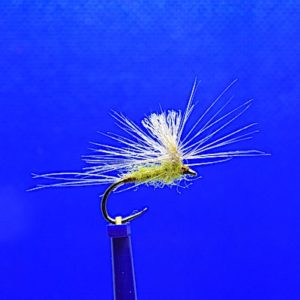
Blue Winged Olive – Parachute
- Hends BL 354 (#16 & 18)
- Olive UNI-thread 8/0
- Tail – iron blue cock
- Body – olive SLF dubbing
- Wing post – Cream Antron yarn
- Hackle – iron blue cock
Wet fly patterns:

Blue Winged Olive wet fly
- Hends BL 354 (#16 & 18)
- Olive UNI-thread 8/0
- Tail – iron blue cock
- Body – olive SLF dubbing
- Hackle – iron blue hen
Nymph pattern:
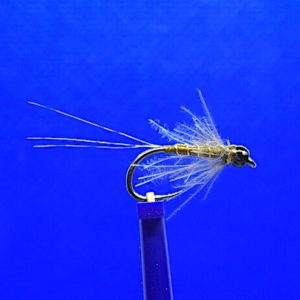
BWO nymph
- Hends BL 354 (#16 & 18)
- Bead – black tungsten
- Olive UNI-thread 8/0
- Tail – 3 Coq-de-leon fibres
- Body – olive thread
- Rib – fine gold wire
- Legs – CDC hackle
For additional information on the Blue Winged Olive patterns and how to fish them check out the following post:
NB. This guide on flies for river fishing with a focus on the Welsh Dee is still being developed and more patterns will be added in the next few weeks. Please let me know if there is anything specific you would like me to add or change. Cheers, Andrew